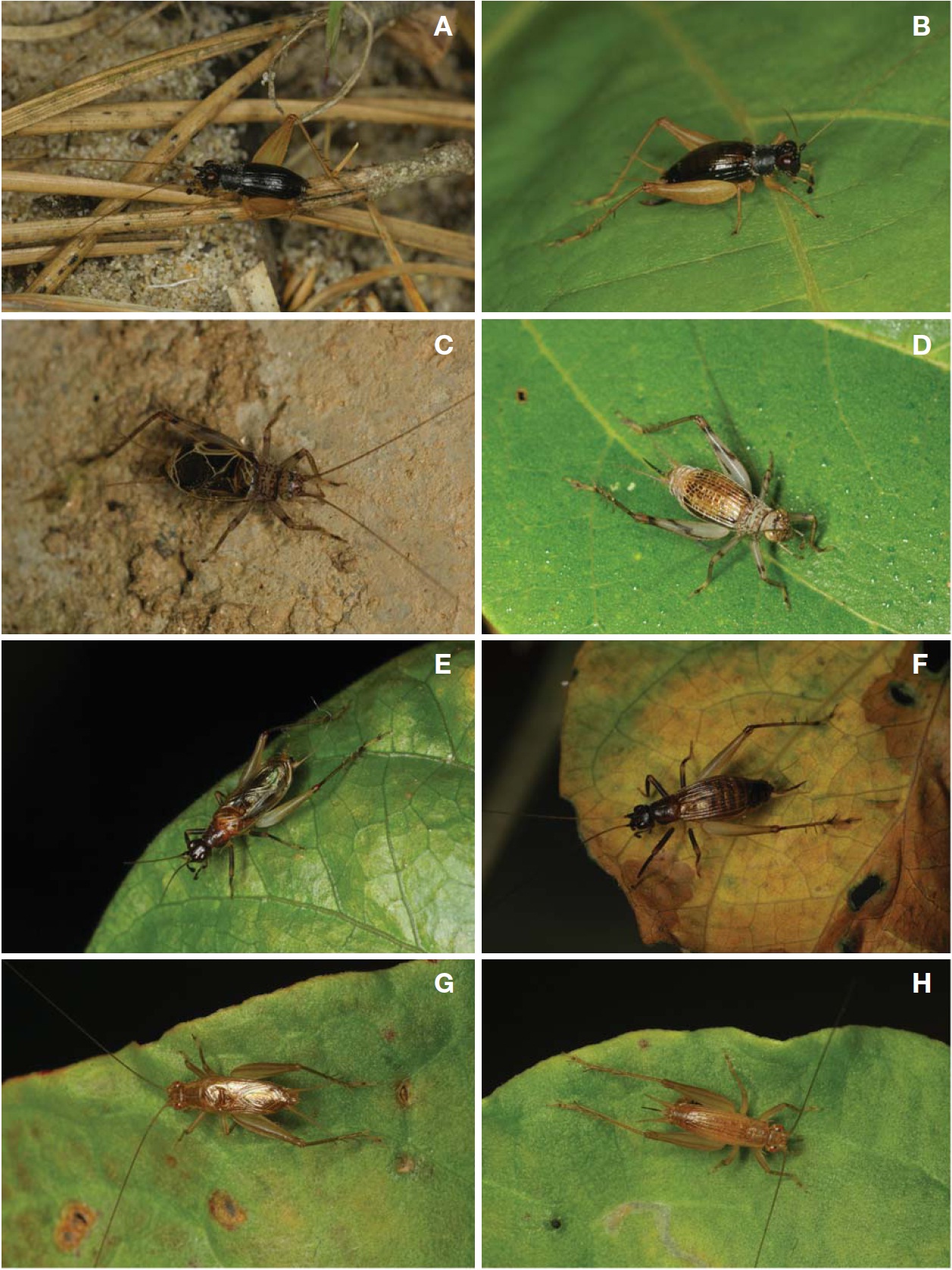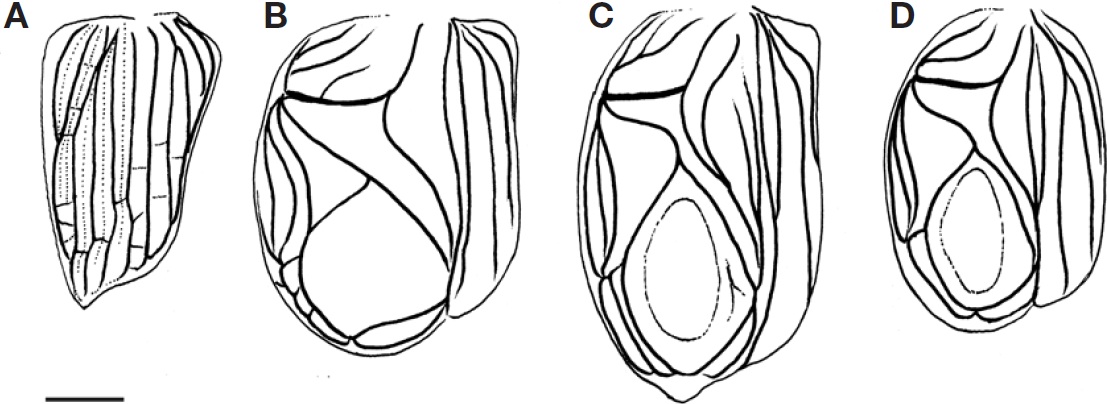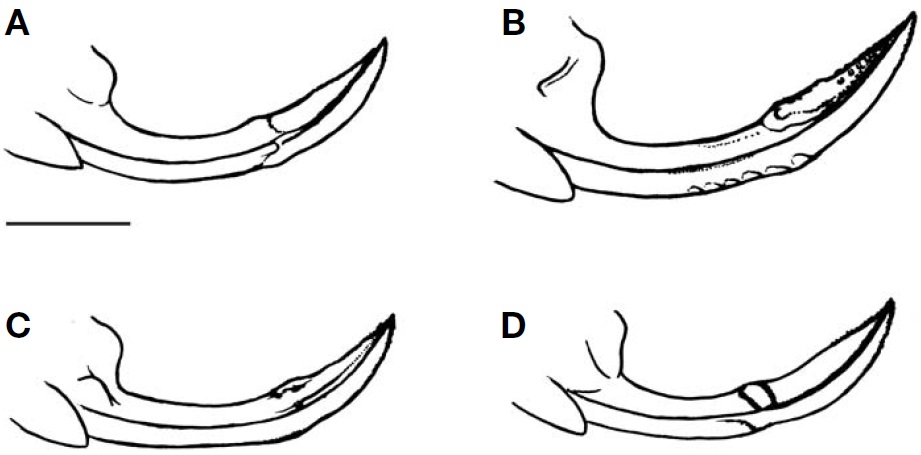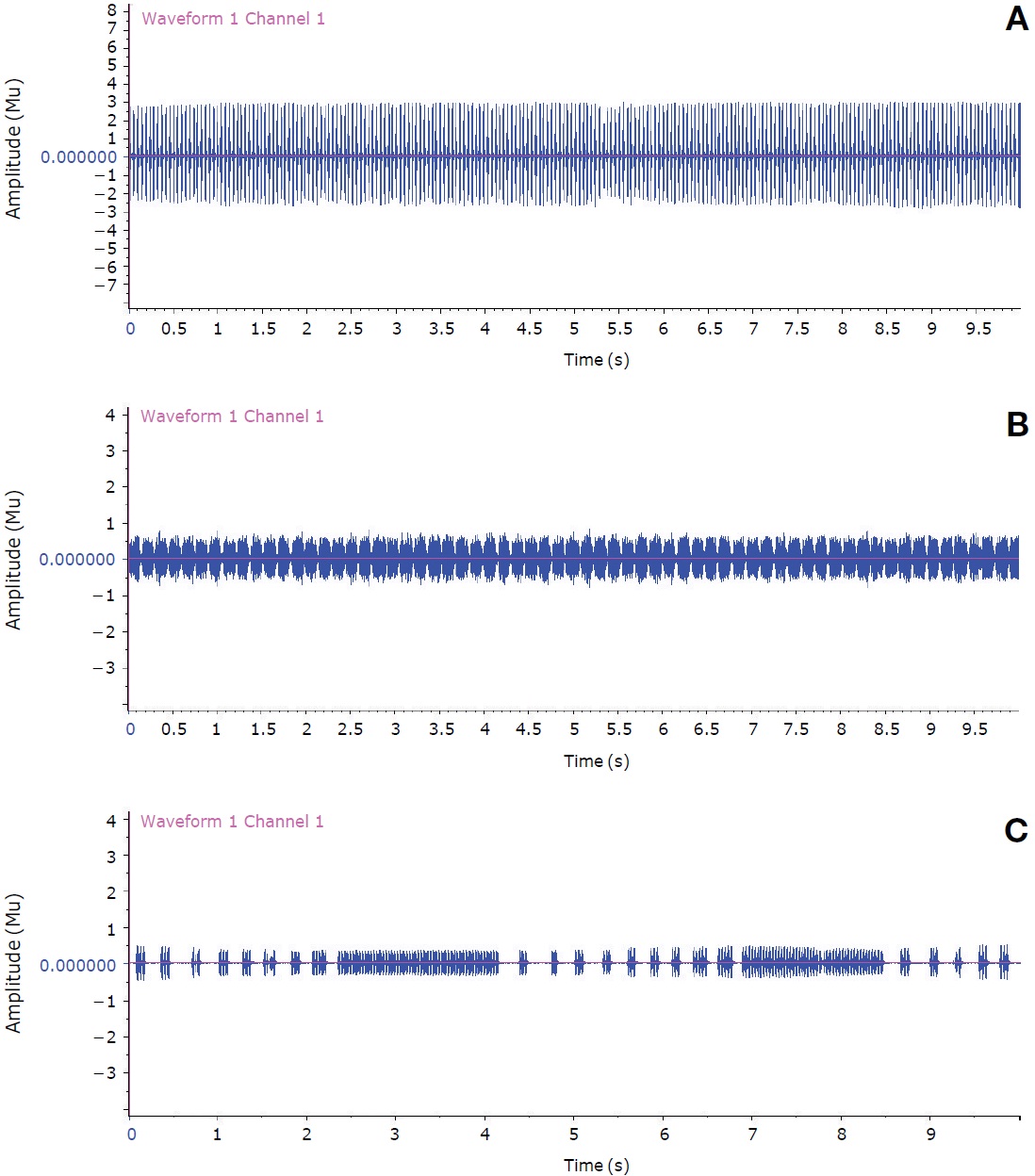



Trigonidiinae is a cricket subfamily, generally called to as the sword-tailed cricket or sword-bearing cricket, because of the peculiar shape of female’s ovipositor (Kevan, 1982). They are also often referred to simply as ‘trigs’ (Otte, 1994b). The sword-shaped ovipositor is equipped for inserting eggs into plant tissue, and the adhesive tarsal pads of the legs are adapted for running upside down on plant leaves (Walker and Masaki, 1989). Considering their small size (4-7 mm), the crickets are readily recognized by their remarkable vivid colorations and crawling behavior on the vegetation during their active seasons. They prefer humid habitats with abundant vegetation, such as swamps, marshes, and bogs, and they can be generally collected by net-sweeping or beating method. More than 33 genera, including 490 species have been known through the world (Otte, 1994a), however, its diversity is still not extensively known due to the lack of comprehensive studies (Rentz, 1996).
Shiraki (1930) reported ‘
During the course of the project ‘The sound guides to Korean animals’ carried out in the National Institute of Biological Resources, the other two Trigonidiinae members were newly discovered from the far southern provinces Jeollanamdo and Jejudo Island. Their calling sounds were successfully recorded and temporary identified as ‘
The main goal of this paper is to taxonomically review the Korean Trigonidiinae. For this goal, four Korean members of Trigonidiinae species were firstly identified using the morphological characters, and then reconfirmed on the basis of calling sounds of each species. This study covers a part of the Korean Orthopteran biodiversity.
Calling sounds were recorded by a digital recorder (PCMD50; Sony, Tokyo, Japan) in an acoustic room, and were analyzed by Raven Pro 1.3 (Cornell Lab of Ornithology) to make out its oscillograms. The terminology for genitalic description refers to Desutter (1987). All voucher specimens are deposited in the dry and wet collections of the National Institute of Biological Resources, Incheon, Korea.
Order Orthoptera Olivier, 1789
Suborder Ensifera Chopard, 1920
Family Gryllidae Laicharting, 1781
Subfamily Trigonidiinae Saussure, 1874
Diagnosis. Body slender and fragile, small size (less than 1 cm), sometimes remarkable with vivid colorations. Head generally wider than anterior margin of pronotum, inverted trigonal shape in anterior view. Second tarsomeres depressed, heart-shaped, bear prominent adhesive pads (ventral pubescence). Hind femur as long as hind tibia; hind tibia not serrulated on dorsum, with three pairs of subapical spurs on both sides; five apical spurs. Ovipositor compressed, generally upwardly curved, its apex sharply pointed.
Key to the species of Trigonidiinae from Korea
1. General coloration dark shining black with yellowish legs; male tegmina without speculum, its venation similar in both sexes; fore tibia without tympanum (non-singing cricket) ????????????????????????????????????????????????
- General coloration not black; male tegmina with speculum, its venation completely different between both sexes; fore tibia with tympanum (singing crickets) ???????????????? 2
2. General coloration brownish gray; male tegmina with wide mirror, as wide as long ????????????????????
- General coloration not gray; male tegmina with narrow mirror, longer than wide ??????????????????????????????????????????? 3
3. General coloration darkish red; pronotum narrowing and rounded in anterior margin; hind femur with an outer dark longitudinal strip ????????????????????
- General coloration unicolorous orange yellow; pronotum with slightly convex anterior margin, but neither strongly rounded nor narrowing; hind femur without strip ????????????????????????????????????????????????????????????????????
Genus Metioche Stal, 1877
Type species:
Diagnosis. Body coloration usually dark black. Pronotum weakly narrowed ahead. Tegmina coriaceous, convex on top, similar to small beetles; principal dorsal veins parallel, without false veins between ones; speculum absent, venation similar between both sexes. Fore tibia without tympana. Male genitalia: hind margin of epiphallus triangularly incised in the middle; hind lateral lophi of epiphallus dentate. 42 species are recorded in the world.
1*Metioche japonica (Ichikawa, 2001) (Table 1, Figs. 1A, B, 2A, 3A, 4A)
Material examined (86 specimens). Korea: Gangwon-do: 1♀, Yanggu, Dutayeon, 12 Jun 1990, Kim JI; 1♂, Pyeongchang, Jinbu, Dongsan-ri, 2 Jul 1985, Chang KS; 1♀, Bukpyeong, Samhwa-sa Temple, 26 Jun 1984, Chang KS; Gyeonggi- do: 1♂, Gapyeong, Mt. Myeongjisan, 9 Jul 1994, Choi HS; 1♀, ibid. 24 Jun 1995, Lee EJ; 1♂, Namyangju, Mt. Cheonmasan, 26 May 1990, Kim SY; 1♀, Yangpyeonggun, Yangseo-myeon, Yangsu-ri, 17 May 1998, Kim TW; 1♂7♀ (emergence from nymphs), Ansan, Yangsang-dong, 12 May-6 Jun 2006, Kim TW; Seoul: 1♀, Gangnam-gu, Heoninneung, 31 May 1988, Jeon NY; 1♂, Nowon-gu, Mt. Suraksan, 9 May 1998, Kang HG; 1♂, Dobong-gu, Mt. Dobongsan, 29 May 1999, Choi EH; 1♂, Eunpyeong-gu, Bulgwang- dong, 6 Jun 1998, Kim TW; 2♂1♀, Eunpyeong-gu, Jinkwannae-dong, Wetland, 6 Jun 2007, Kim TW; Gyeonggi- do: 1♂, Dongducheon, Jihaeng-dong, 30 May 1999, Kim YE; 1♀, Incheon, Seo-gu, Gyeongseo-dong, 18 Oct 2010, Kim TW; 1♂, Yeoju-gun, Sanbuk-myeon, Baekja-ri, 15 Jul 2010, Park SW; 1♂, Seongnam-si, Sujeong-gu, Sangdapdong,
[Table 1.] Measurements of Trigonidiinae from Korea

Measurements of Trigonidiinae from Korea
7 Jul 2010, Park SW; 1♀, Yangpyeong-gun, Gaegunmyeon, Nae-ri, 9 Jul 2010, Park SW; 1♀, Yongin-si, Cheoin- gu, Neungwon-ri, 14 Jul 2010, Park SW; 1♂, Gwangju-si, Docheok-myeon, Sanglim-ri, 14 Jul 2010, Park SW; Chungcheongbuk- do: 2♂, Chungju, Mt. Gyemyeongsan, Yonggokmaeul Village, 17 May 2003, Han GD, Kim TW; 1♀, Cheongcheon, Songmyeon-ri, 23 Jun 1989, Cho HS; Chungcheongnam- do: 1♂, Taean, Wonbuk-myeon, Sindu-ri, 3 Jul 2009, Kim TW; 1♀, Taean, Mt. Baekhwasan, Naengjeonggol, 22 Jun 2001, Hwang JH; 1♀, Cheonan, Suin-myeon, Baekjal-ri, 6 Jun 2008, Park SW; 1♂, Seocheon-gun, Habsan- myeon, Namseong-ri, 12 Jun 2010, Park SW; 1♂, Daejeon- si, Yuseong-gu, Seongbuk-dong, 22 May 2009, Park SW; 1♂, Cheongyang-gun, Jeongsan-myeon, Daebak-ri, 14 Jun 2009, Park SW; 1♀, Cheongyang-gun, Hwaseong-myeon, Hwaam-ri, 14 Jun 2009, Park SW; 1♀, Cheongyang-gun, Daechi-myeon, Gwanggeum-ri, 14 Jun 2009, Park SW; 2♂, Nonsan-si, Sangweol-myeon, Eoeun-ri, 24 May 2009, Park SW; Gyeongsangbuk-do: 1♀, Uljin, Mt. Baekamsan 29 May 1999, Kim TW; 1♂, Bonghwa, Seokpo, Daehyeon, 24 Jul 1986, Chang KS; 1♀, Gumi-si, Okseong-myeon, Nongso- ri, 20 Jul 2009, Park SW; 1♂, Sangju-si, Hwanammyeon, Imo-ri, 29 Jul 2009, Park SW; 1♀, Sangju-si, Nakdong- myeon, Yongpo-ri, 19 Jun 2009, Park SW; Gyeongsangnam- do: 3♀ (sweeping), Sacheon-si, Waryong-dong, Mt. Waryongsan, 23 May 1998, Park JS; 1♀, Masan, Hoewongu, Hapseong 2-dong, Mt. Palryongsan, 28-29 Jun 2000, Paik SH; 2♂1♀, Yangsan, Sangbuk-myeon, Daeseok-ri, Mt. Wonhyosan, Heungryong-sa Temple, 20 Jul 2002, Park JS, Shin JS; 1♂, Haman, Gunbuk-myeon, Bakgok-ri, Sugokneup Swamp, 20 May 2002, Ahn TH; 10♂6♀, Busan-si, Yeongdo-gu, Dongsam-dong, Gosin University Campus, Lee JW et al.; 1♀, Geoje-si, Mt. Bukbyeongsan, Simwon-sa Temple, 11 Jun 2009, Kim TW; Jeollabuk-do: 1♂1♀, Jeongeup, Mt. Naejangsan, 26 May 1994, Kim HE, Kim HJ; 1♀, Iksan-si, Geumma-myeon, Sinryong-ri, Dadeumjae, 11 Jun 2010, Park SW; 1♀, Iksan-si, Ungpo-myeon, Songcheonri, Mt. Hamrasan, 10 Jun 2010, Park SW; Jeollanam-do: 1♀, Jindo, Cheongdeungdo Island, 29 Jul 1983, Kim JI; 2♂1♀, Gwangyang-si, Eochi-ri, Mt. Baekunsan 26 May 2005, Paik JC; 1♀, Gwangyang, Dapgok-ri, 10 Aug 1993, Ha SY; Jejudo: 2♂, Namjeju, Andeok-myeon, Sagye-ri, Mt. Sanbangsan, 12 Jun 2004, Kim JK, Kim TW; 1♀, Jeju-si, Bonggaedong, Jeolmul Forest, 10 Jun 2006, Kang W; 1♂1♀ (emergence from nymphs), Bukjeju-gun, Hangyeong-myeon, Yongsu- ri, Seobu Reservoir, 21 Apr-31 May 2011, Kim TW.
Description. General: Body coloration dark shining black with bright yellow appendages, without distinct maculae, looks like to small coleopteroids.
Male (Fig. 1A). Head: Dark black. Eyes large, widely separated, darkish red in living specimens; inner margins of eyes more brightly rimed; interocular distance two times wider than horizontal diameter of eye; fastigium of vertex as wide as horizontal diameter of antennal socket; scape and pedicel dark black, flagellum bright; apical segment of maxillary palpus black, hatchet-shaped. Pronotum: 1.2 times wider than long in dorsal view, pilose; anterior and posterior both margins truncated; a median longitudinal groove present on half of front; lateral lobe of pronotum as deep as pronotal length. Wings: Tegmina dark shining black, convex on top; macropterous, slightly exceeding abdominal end, apex rather pointedly projected; stridulatory apparatus absent; false veins indistinct, cross veins sparsely present on apical half; lateral field deeper than lateral lobe of pronotum. Hind wings absent. Legs: Fore tibia without tympana. Middle tarsomeres smaller and darkish, depressed. Hind femur three times longer than middle femur; hind tibia with three pairs of dorsal spines on both sides posteriorly; largest inner apical spur two thirds as long as basitarsus; hind basitarsus longer than combined length of remaining two tarsomeres. Abdomen: All parts black. Cercus yellowish, as long as middle femur. Subgenital plate trapezoidal, 1.2 times wider than long, its hind margin weakly concave with a small projected medial lobe. Genitalia: Epiphallus with wide dorsal plate, triangularly incised on the middle of hind margin; hind lateral lophi dentate, its apex more projected to finger-shape.
Female (Fig. 1B). Tegminal venation similar with male, but rather hyaline, less dark than male. Cercus as long as ovipositor. Subgenital plate roundly triangular, as long as basal width, its hind margin hardly notched at middle apex. Ovipositor strongly upcurved, half as long as hind femur; two thirds area from base rather widened and bumpy; dorsal valves weakly serrated apically.
Distribution. Korea, Japan.
Remarks. This is a non-singing cricket, the adult active from spring to summer seasons (Kim, 2011). Overwintering as nymphal stages, as same to known from Japan (Ichikawa et al., 2000).
Genus Svistella Gorochov, 1987
Type species:
Diagnosis. Body coloration usually bright with dark maculations. Male tegmina sufficiently wider, macropterous; speculum more or less oval, as long as wide; stridulatory apparatus present. Female tegmina corneous, convex on top. Fore tibia with tympana. Male genitalia: epiphallus with strongly incised hind margin; hind lateral lophi of epiphallus with long and narrow projection at apex. Ovipositor finely denticulate. Six species are known from South-East Asia.
1*Svistella bifasciata (Shiraki, 1911) (Table 1, Figs. 1C, D, 2B, 3B, 4B, 5A)
Material examined (54 specimens). Korea: Gangwon-do: 2♀, Cheolwon, Mt. Myeongseongsan, 3 Jul 1999, Kim TW; Gyeonggi-do: 1♀, Gapyeong, Mt. Hwayasan, 26 Aug 2002,
Jeong MP; 1♂, Namyangju, Joan-myeon, Mt. Ungilsan, 13 Sep 1998, Kim TW; 1♂1♀, Yangpyeong, Mt. Cheonggyesan, 26 Aug 2002, Jeong MP; 1♀, Paju, Mt. Wolrongsan, 29 Aug 2002, Jeong MP; 1♂, Pocheon, Gwangneung, 17 Oct 1999, Sohn JC; 1♂ (pitfall), Hwaseong, Bongdam-myeon, Deokwu-ri, 24 Sep 2001, Jeong MP; Seoul: 1♂, Nowon-gu, Mt. Suraksan, 4 Sep 1995, Min Y; 1♂, Seosamneung, 18 Sep 1971, Seon MH; 1♂1♀, Mt. Achasan, 24 Aug 1980, Chang KS; 1♂, ibid. 12 Sep 1981, Yoon SJ; 3♂, Eunpyeonggu, Mt. Bukhansan, 11-12 Aug 2004, Kim TW; Incheon: 1♂1♀, Seo-gu, Gyeongseo-dong, 18 Oct 2010, Kim TW; Chungcheongbuk-do: 1♀, Boeun, Hyeon-ri, 13 Oct 2000, anonym; Chungcheongnam-do: 1♀, Buyeo-gun, Seokseongmyeon, Seokseong-ri, 29 Sep 2010, Park SW; 1♂, Buyeogun, Oksan-myeon, Daedeok-ri, 29 Sep 2010, Park SW; 1♀, Boryeong-gun, Jusan-myeon, Singu-ri, 29 Sep 2010, Park SW; Gyeongsangbuk-do: 1♀, Sancheong-gun, Sancheongeup, 16 Sep 2010, Kim TW; Gyeongsangnam-do: 2♀, Changnyeong- gun, Daehap-myeon, Jumae-ri, Somokmaeul Village, Upo Swamp, 15-16 Sep 2001, Park JS, Shin JS; 2♀ (light trap), Goseong, Hail-myeon, Yongtae-ri, Samtae, Mt. Sanseongsan, 18-19 Aug 1998, Park JS, Park KY; 2♂, Sancheong, Mt. Jeongsusan, Yulgoksa, 6 Sep 1998, Jeon JS; 1♂ (light trap), Hadong, Jingyo-myeon, Goryong-ri, Mt. Geumosan, Geumseongsa, 14-15 Sep 1998, Jeon JS; 2♀, Geochang- gun, Wicheon-myeon, Sangcheon-ri, Mt. Geumwonsan, 17 Oct 2009, Park JS; 4♀, Gimhae-si, Saengnimmyeon, Saengnim-ri, 20 Aug 2009, Park JS; Jeollabuk-do: 3♂1♀ (pitfall), Buan, Haseo, Haechang-ri, 24 Sep-12 Nov 2001, Jeong MP; 1♀, Gimje, Geumsan-sa Temple, 19 Sep 1992, Park JM; Jeollanam-do: 1♂, Yeonggwang, Samgyemyeon, Sangi-ri, Mt. Taecheongsan, Bongjeong-sa Temple, 4 Sep 1998, Park JS; 1♀, Hwasun-gun, Hwasun-eup, 24 Aug 2009, Jeon JA; Jeju-do: 1♂3♀ (emergence from nymphs), Namjeju, Andeok-myeon, Sagye-ri, Mt. Sanbangsan, 14 Aug-1 Sep 2004, Kim JK, Kim TW; 1♀, Bukjeju, Gujoaeup, Deokcheon-ri, 1 Aug 2003, Cho SW et al.; 1♂1♀, Bukjeju-gun, Jocheon-eup, Seonheul-ri, Dongbaekdongsan Forest, 16 Oct 2008, Kim TW; 3♀, Jeju-si, Arail-dong, Gwaneum- sa Temple, 17 Sep 2009, Park JS.
Description. General: Body coloration brownish gray with distinct dark maculae on tegmina and appendages.
Male (Fig. 1C). Head: Short and vertical, wider than anterior margin of pronotum; interocular distance 1.7 times wider than horizontal diameter of eye, a black transverse strip present in this area; fastigium of vertex narrower than eye or antennal socket in dorsal view. Scape 1.2 times longer than it is wide; inner margin of antennal socket darkish rimed, the horizontal diameter 2.2 times wider than narrowest distance between antennal sockets; subocular and areas behind eyes with dark patches; last segments of maxillary palpus hatchet-shaped. Pronotum: Shorter than wide in dorsal view, with scattered dark patches; anterior and lateral margins darkish rimed, pilose; posterior margin truncated with numerous hairs; lateral lobe of pronotum slightly deeper than pronotal length. Wings: Tegmina wider than posterior margin of pronotum; macropterous, covering abdominal end; veins white, postcubital area transparent with dark maculation; one harp vein; mirror area large, occupying nearly half of dorsal surface, not divided, as wide as long; apical area vestigial; lateral field blackish, slightly deeper than lateral lobe of pronotum. Hind wings vestigial. Legs: Fore tibia with distinctly oval-shaped outer tympanum, but inner one indistinct. Fore and middle femora subapically black banded; hind femur with two outer longitudinal strips, dorsal one thin, ventral one thick. Hind tibia with three pairs of dorsal
spines on both sides posteriorly; largest inner apical spur half as long as basitarsus. Hind basitasus with a dorsal apical spine, slightly longer than combined length of remaining two tarsomeres. Abdomen: Sternal parts darkish. Cercus 1.2 times longer than half of hind tibia. Subgenital plate wider than it is long, its hind margin widely concave with a small projected medial lobe; posteriorly brightly rimed. Genitalia: Epiphallus strongly incised in the middle of hind margin; hind lateral lophi of epiphallus with long and narrow projection at apex; bristle present at apex and inner hind margins.
Female (Fig. 1D). Tegmina narrower than in male, with distinctly raised longitudinal veins and weakly netted cross veins; apex narrowly rounded; macropterous forms of hind wings present. Cercus longer than ovipositor. Subgenital plate wider than it is long, its hind margin deeply incised forming two lateral lobes. Ovipositor strongly upcurved, half as long as hind femur; three fifth area from base rather widened and bumpy with a dorsal groove; a fifth of dorsal valves tuberculate, strongly serrated towards apex. Calling sound (Fig. 5A): Simply ring-tone sound, each syllable continuous for more than one minute. Chirping rate 22-24 per second at 24℃.
Distribution. Korea, Japan, China, Taiwan, Vietnam.
Genus Homoeoxipha Saussure, 1874
Type species:
Diagnosis. Body coloration usually darkish red. Head black, as long as it is wide in dorsal view. Pronotum narrowing and rounded in anterior margin, wider in posterior margin, looks like to forming elongated slender neck. Male tegmina narrower, speculum longer than wide; stridulatory apparatus present. Female tegmina feebly convex, with false veins between principle longitudinal veins. Fore tibia with inner and outer tympana. Male genitalia: epiphallus with V-shaped emargination on hind margin; hind lateral lophi of epiphallus triangular. Ten species are known from the Old World.
1*Homoeoxipha obliterata (Caudell, 1927) (Table 1, Figs. 1E, F, 2C, 3C, 4C, 5B)
Material examined (10 specimens). Korea: Jeju-do: 2♂ (rearing, emergence from nymphs), Namjeju, Andeok-myeon, Sagye-ri, Mt. Sanbangsan, 14 Aug-1 Sep 2004, Kim TW; 6♂2♀ (net-sweeping), Jeju-si, Odeung-dong, Gwaneum-sa Temple, 16 Sep 2009, Kim TW.
Description. General: Body coloration pale darkish red, hind margin of pronotum and tegminal base more reddish. Fore and middle legs dark black. Hind femur with a dark longitudinal strip on outer margin.
Male (Fig. 1E). Head: Rather round, as wide as hind margin of pronotum; interocular distance 1.5 times wider than horizontal diameter of eye; fastigium of vertex as wide as horizontal diameter of antennal sockets. Scape and pedicel dark black, flagellum bright. Apical segments of palpi hatchet- shaped. Pronotum: As long as it is wide, narrowing and rounded on anterior margin, widened and truncated on posterior margin, pilose; lateral lobe of pronotum as deep as pronotal length. Wings: Tegmina wider than hind margin of pronotum; macropterous, fully covering abdomen; postcubital area hyaline with obscure maculation; harp vein one, sigmoid from right to left; mirror area narrower, 1.7 times longer than wide, occupying three fifths of dorsal surface, not divided, with a small concentric inner veinlet; apical area vestigial; lateral filed darkish, deeper than lateral lobe of pronotum. Hind wings vestigial. Legs: Fore tibia with distinctly oval-shaped outer tympana, but inner one absent. Hind femur with one outer darkish longitudinal strip; hind tibia with three pairs of dorsal spines on both sides; largest inner apical spur as long as an half of basitarsus. Hind basitarsus 0.7 times as long as combined length of two remaining tarsomeres. Abdomen: All parts black. Cercus as long as an half of hind femur. Subgenital plate roundly triangular, shorter than basal width, its hind margin narrowly truncated. Genitalia: Epiphallus with narrow hind margin, its apex with V-shaped emargination forming a pair of hind lateral lophi; inner margin with short hairs.
Female (Fig. 1F). Tegmina narrower than in male, with distinctly raised longitudinal veins, false veins and weakly netted cross veins; apex narrowly rounded. Cercus shorter than ovipositor. Subgenital plate two times wider than long, its hind margin roundly triangular. Ovipositor upcurved, half as long as hind femur; three fourths of the area rather widened and bumpy with small tubercles; dorsal valves weakly serrated subapically. Calling sound (Fig. 5B): Rhythmical repetition sound, each syllable continuous for more than one minute. Chirping rate 6-7 per second at 21℃.
Distribution. Korea: Jejudo Island (new record), Japan.
Genus Natula Gorochov, 1987
Type species:
Diagnosis. Body coloration unicolorous, bright single-tone. Head wider than anterior margin of pronotum, but narrower than hind margin of pronotum. Pronotum with roundly convex anterior margin. Male tegmina narrower, speculum longer than it is wide; stridulatory apparatus present. Female tegmina feebly convex. Fore tibia with large inner and outer tympana. Male genitalia rather asymmetrical; epiphallus with broadly truncated hind margin, without median incision; hind lateral lophi of epiphallus with widely separated projection at apex; ventral side of hind lateral lophi forming parameres. Six species are known from the Old World.
2*Natula matsuurai Sugimoto, 2001 (Table 1, Figs. 1G, H, 2D, 3D, 4D, 5C)
Material examined (8 specimens). Korea: Jeollanam-do: 1♀, Yeosu, 19 Aug 2008, Kim SS; 2♂1♀ (net-sweeping), Wando-gun, Wando-eup, Doam-ri, Doam Reservoir, 19 Jul 2012, Kim TW; Jeju-do: 2♂2♀ (net-sweeping), Bukjejugun, Hangyeong-myeon, Yongsu-ri, Seobu Reservoir, 21 Apr 2011, Kim TW.
Description. General: Body coloration unicolorous orange yellow including all appendages. Face with a transverse dark strip along with higher margin of epistomal suture from beneath both eyes.
Male (Fig. 1G). Head: As long as pronotal length, as wide as hind margin of pronotum; interocular distance 1.7 times wider than horizontal diameter of eye; fastigium of vertex as wide as horizontal diameter of antennal sockets; scape 1.5 times longer than wide; last segments of palpi hatchetshaped. Pronotum: 1.5 times wider than long, anterior and posterior margins truncated, pilose; lateral lobe of pronotum as deep as pronotal length. Wings: Tegmina wider than hind margin of pronotum; macropterous, covering all abdomen; postcubital area hyaline without any maculation; harp vein one; mirror area 1.5 times longer than width, occupying half of dorsal surface, not divided, with a small concentric inner veinlet; apical area vestigial; lateral filed deeper than lateral lobe of pronotum. Hind wings apterous. Legs: Fore tibia with oval-shaped outer and inner tympanum. Hind femur without strip; hind tibia with three pairs of dorsal spines on both sides posteriorly; largest inner apical spur as long as an half of basitarsus. Hind basitarsus 0.5 times longer than combined length of remaining two tarsomeres. Abdomen: Cercus 0.7 times longer than half of hind femur. Subgenital plate longer than it is wide, its hind margin narrowly truncated, with a small projected medial lobe. Genitalia: Epiphallus with broadly truncated hind margin; hind lateral lophi of epiphallus with elongated projection at apex, its inner margin rather serrulated; ventral side of hind lateral lophi with broad blade, its margin feebly curved. Left projection more developed than right one.
Female (Fig. 1H). Tegmina narrower than in male, with distinctly raised longitudinal veins and weakly netted cross veins; apex narrowly rounded. Macropterous hind wings observed. Cercus as long as ovipositor. Subgenital plate two times wider than long, its hind margin roundly triangular. Ovipositor strongly upcurved, half as long as hind femur; three fifths area from base rather widened and bumpy, with a dorsal groove; dorsal valves weakly serrated on a fifth of apices. Calling sound (Fig. 5C): Continuous ring-tone sound lasting more than one minute, which consists of two particularly different type series; first slowly long term phrase and latter speedy short term phrase, those are alternatively repeated; a set recurs every 4-6 s, the chirping rate of the first slow phrase 9-15 per set, the speed-up phrase lasted 1.5 s at 20℃.
Distribution. Korea (new record), Japan.
Korean name: 1*먹종다리
Korean name: 1*풀종다리
Korean name: 1*홍가슴종다리(신칭), 2*새금빛종다리(신칭)





